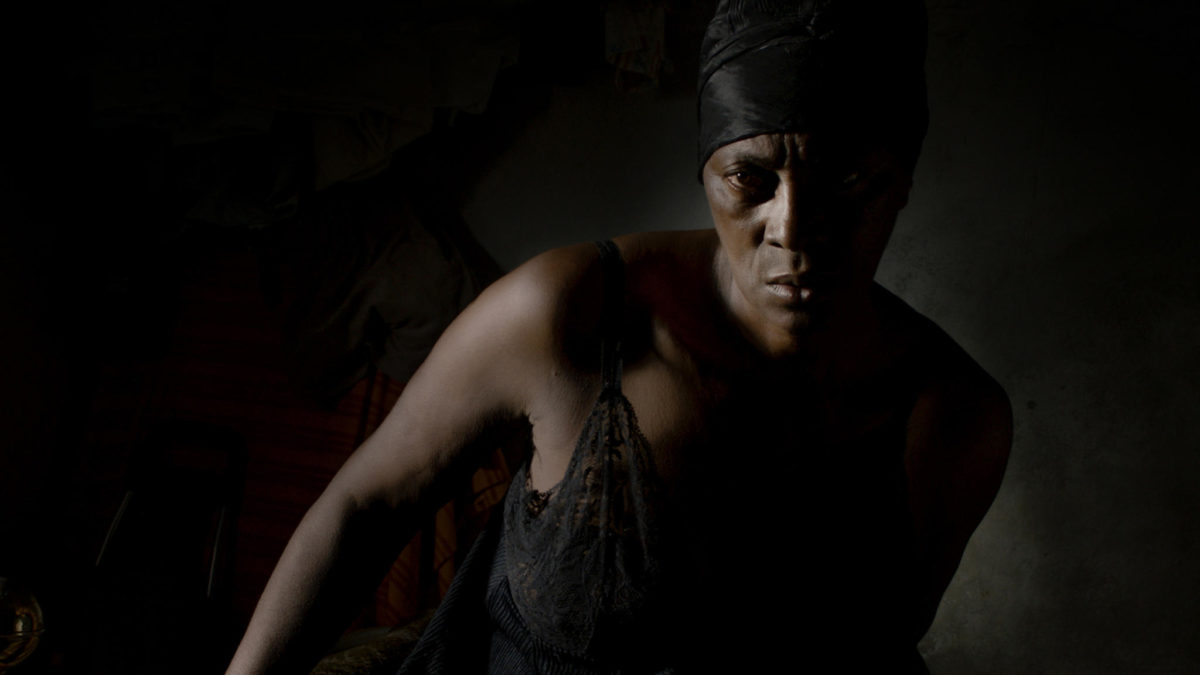A languid procession of men, enveloped by their nocturnal surroundings, creep back to their concrete homes in the Lisbon neighbourhood of Cova da Moura where the burning of old photographs and incense signifies it’s all a part of a ritualized attempt to bury the past. Following this choreographed display of dejection and mourning we see a shadowy figure arrive at the airport at night. It’s the silhouette of a woman waiting for the airstair to slide into view. She steps off her plane barefoot with piss streaming slowly down her legs. Her name is Vitalina Varela and she’s come all the way from the former Portuguese colony of Cape Verde for the funeral of her late husband Joaquim whom she hasn’t seen in 40 years. Unlike the men in the opening scenes Vitalina clings to the past—to her spouse whose now just a memory and a structuring absence that appears only through photographs and stories. The only ones coming to greet Vitalina are the airport’s cleaning ladies—working class people emerging silently from the shadows like all of director Pedro Costa’s subjects. They are the myrrh bearers of the wary and the downtrodden but instead of announcing the evangelion of resurrection and hope, they whisper solemnly in Vitalina’s ear that she’s missed her husband’s funeral which was exactly three days ago and that she should turn back.
This painful subversion of myth (be it biblical or other) is a gesture Costa will repeat throughout this latest instalment in his decades long series of films that let the dispossessed and marginalized members of the Cape Verdean diaspora in Lisbon tell their own stories through soliloquies often whispered in measured confessional tone. As is the case with Vitalina Varela, these evocative personal tales of love, poverty, and working class martyrdom come into their own through Costa’s unique visual style, now famous for its unparalleled chiaroscuro lighting, darkly picturesque framing of urban decay, and stoic expressions of constant grief which appear mainly on the faces of the all too real “characters” (in most of his films people play themselves). This idiosyncratic aesthetic lures us into thinking that an unending night has swallowed up the world of the Cape Vardeans and that we are granted the stories of these ghostly figures only because the camera has conjured them up for us, carving them out of pure darkness with the help of the artificial light coming from the few pieces of equipment Costa has brought into their land of shadows. On top of that, the long takes and the black void enveloping almost every single object in each frame obfuscates the idea of any intelligible spatial whole. This effect reinforces the dreamlike quality of the visuals which are reminiscent more of a series of carefully crafted tableaux vivants than of scenes following montage’s inherently dialectical logic.
In Costa’s latest, his style is there to frame and emphasize all the shadows of history and myth that will forever haunt Vitalina in confused and twisted ways because she’s a poor immigrant betrayed by the man who, in love and work, shared her class-struggle. By leaving the little he had for a life in the slums of Lisbon, Joaquim not only effectively became a colonised subject once more, but also a sort of Odyssean wanderer who never actually wants to see his Ithaca again so his Penelope has to do all the heavy lifting and bring “home” to him. That’s why the parallels with the Homeric story are visually overt—Vitalina is surrounded by potential suitors on several occasions in her late husband’s rundown home but rejects them believing she’ll be reunited with Joaquim in some eschatological sense. Her stoic faith in God is actually the thing keeping her going even though her journey and the sacrifices she continues to make in the name of love are in a sense meaningless—after all (as everyone points out in the film) there is nothing for her in Portugal. So Vitalina’s hard-boiled religiosity seems absurd in a world obviously devoid of any transcendence—of love, hope and even of something as basic as light—but at the same time it is the source of her strength. It’s what gives her the right and fortitude to challenge and subvert male-centric mythopoesis.
Ultimately, even though Costa has been cultivating his singular approach since In Vanda’s Room (2000), what makes Vitalina Varela really stand out is its portrayal of a woman’s ascetic renunciation of man’s self-centred search for meaning and a better life. But that is not to say that there aren’t any noteworthy developments on a stylistic level. In comparison with earlier projects like Horse Money (2014) or Colossal Youth (2006), Vitalina Varela is so oppressively steeped in darkness that it pushes Costa’s usual conceptual and visual devices to their limit. That’s why, at the end of the film, we get an ecstatic contrapunctus—young Vitalina and Joaquim working on their house in Cape Verde together in broad daylight. The house is probably the only product of unalienated labour we get to see in the director’s filmography and as a calming visual respite, breaks down the visual tension built up in the decades Costa has been developing his austere style. But still, as bucolic as the scene is, it still remains only a shadow of a memory of Vitalina’s own paradise lost.
